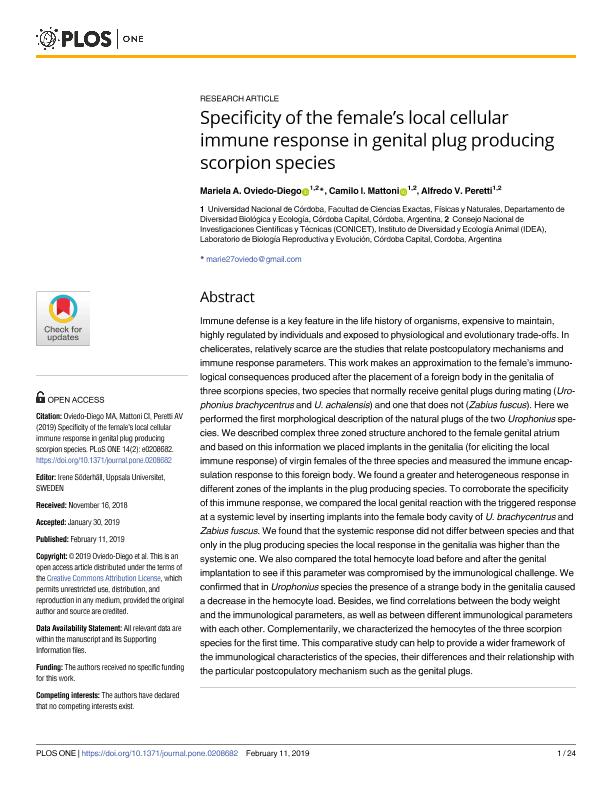Mostrar el registro sencillo del ítem
dc.contributor.author
Oviedo Diego, Mariela Anahí

dc.contributor.author
Mattoni, Camilo Ivan

dc.contributor.author
Peretti, Alfredo Vicente

dc.date.available
2020-12-17T13:53:18Z
dc.date.issued
2019-02-11
dc.identifier.citation
Oviedo Diego, Mariela Anahí; Mattoni, Camilo Ivan; Peretti, Alfredo Vicente; Specificity of the female's local cellular immune response in genital plug producing scorpion species; Public Library of Science; Plos One; 14; 2; 11-2-2019; 1-24
dc.identifier.uri
http://hdl.handle.net/11336/120733
dc.description.abstract
Immune defense is a key feature in the life history of organisms, expensive to maintain, highly regulated by individuals and exposed to physiological and evolutionary trade-offs. In chelicerates, relatively scarce are the studies that relate postcopulatory mechanisms and immune response parameters. This work makes an approximation to the female´s immunological consequences produced after the placement of a foreign body in the genitalia of three scorpions species, two species that normally receive genital plugs during mating (Urophonius brachycentrus and U. achalensis) and one that does not (Zabius fuscus). Here we performed the first morphological description of the natural plugs of the two Urophonius species. We described complex three zoned structure anchored to the female genital atrium and based on this information we placed implants in the genitalia (for eliciting the local immune response) of virgin females of the three species and measured the immune encapsulation response to this foreign body. We found a greater and heterogeneous response in different zones of the implants in the plug producing species. To corroborate the specificity of this immune response, we compared the local genital reaction with the triggered response at a systemic level by inserting implants into the female body cavity of U. brachycentrus and Zabius fuscus. We found that the systemic response did not differ between species and that only in the plug producing species the local response in the genitalia was higher than the systemic one. We also compared the total hemocyte load before and after the genital implantation to see if this parameter was compromised by the immunological challenge. We confirmed that in Urophonius species the presence of a strange body in the genitalia caused a decrease in the hemocyte load. Besides, we find correlations between the body weight and the immunological parameters, as well as between different immunological parameters with each other. Complementarily, we characterized the hemocytes of the three scorpion species for the first time. This comparative study can help to provide a wider framework of the immunological characteristics of the species, their differences and their relationship with the particular postcopulatory mechanism such as the genital plugs
dc.format
application/pdf
dc.language.iso
eng
dc.publisher
Public Library of Science

dc.rights
info:eu-repo/semantics/openAccess
dc.rights.uri
https://creativecommons.org/licenses/by-nc-sa/2.5/ar/
dc.subject
IMMUNE RESPONSE
dc.subject
HEMOCYTES
dc.subject
GENITAL ANATOMY
dc.subject
SCORPIONS
dc.subject
MEDICAL IMPLANTS
dc.subject
CYTOPLASMI INCLUSIONS
dc.subject
CYTOPLASM
dc.subject
SPERM
dc.subject.classification
Zoología, Ornitología, Entomología, Etología

dc.subject.classification
Ciencias Biológicas

dc.subject.classification
CIENCIAS NATURALES Y EXACTAS

dc.title
Specificity of the female's local cellular immune response in genital plug producing scorpion species
dc.type
info:eu-repo/semantics/article
dc.type
info:ar-repo/semantics/artículo
dc.type
info:eu-repo/semantics/publishedVersion
dc.date.updated
2020-11-19T21:14:38Z
dc.identifier.eissn
1932-6203
dc.journal.volume
14
dc.journal.number
2
dc.journal.pagination
1-24
dc.journal.pais
Estados Unidos

dc.journal.ciudad
San Francisco
dc.description.fil
Fil: Oviedo Diego, Mariela Anahí. Consejo Nacional de Investigaciones Científicas y Técnicas. Centro Científico Tecnológico Conicet - Córdoba. Instituto de Diversidad y Ecología Animal. Universidad Nacional de Córdoba. Facultad de Ciencias Exactas Físicas y Naturales. Instituto de Diversidad y Ecología Animal; Argentina
dc.description.fil
Fil: Mattoni, Camilo Ivan. Consejo Nacional de Investigaciones Científicas y Técnicas. Centro Científico Tecnológico Conicet - Córdoba. Instituto de Diversidad y Ecología Animal. Universidad Nacional de Córdoba. Facultad de Ciencias Exactas Físicas y Naturales. Instituto de Diversidad y Ecología Animal; Argentina
dc.description.fil
Fil: Peretti, Alfredo Vicente. Consejo Nacional de Investigaciones Científicas y Técnicas. Centro Científico Tecnológico Conicet - Córdoba. Instituto de Diversidad y Ecología Animal. Universidad Nacional de Córdoba. Facultad de Ciencias Exactas Físicas y Naturales. Instituto de Diversidad y Ecología Animal; Argentina
dc.journal.title
Plos One

dc.relation.alternativeid
info:eu-repo/semantics/altIdentifier/doi/http://dx.doi.org/10.1371/journal.pone.0208682
dc.relation.alternativeid
info:eu-repo/semantics/altIdentifier/url/https://journals.plos.org/plosone/article?id=10.1371/journal.pone.0208682
Archivos asociados
